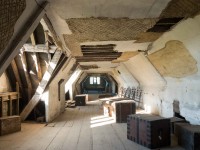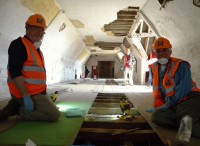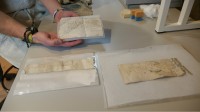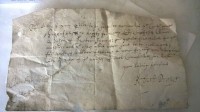 The original Knole House, a stately home in Kent, was a medieval manor house that in 1456 became a palace of the Archbishops of Canterbury who extensively rebuilt and expanded it. It was claimed by Crown during the Reformation; Henry VIII used it as a hunting lodge. In 1603 it was given to Thomas Sackville, 1st Earl of Dorset, Lord High Treasurer and cousin of Anne Boleyn. Sackville began a years-long program of reconstruction and refurbishment to prepare the house for a visit from King James I that never ended up happening, which is a shame because those protective witchmarks scratched into the wooden beams of the king’s rooms during construction in early 1606 went to waste. His descendants followed in his footsteps, doing extensive renovations at the end of the 17th and 18th centuries.
The original Knole House, a stately home in Kent, was a medieval manor house that in 1456 became a palace of the Archbishops of Canterbury who extensively rebuilt and expanded it. It was claimed by Crown during the Reformation; Henry VIII used it as a hunting lodge. In 1603 it was given to Thomas Sackville, 1st Earl of Dorset, Lord High Treasurer and cousin of Anne Boleyn. Sackville began a years-long program of reconstruction and refurbishment to prepare the house for a visit from King James I that never ended up happening, which is a shame because those protective witchmarks scratched into the wooden beams of the king’s rooms during construction in early 1606 went to waste. His descendants followed in his footsteps, doing extensive renovations at the end of the 17th and 18th centuries.
 Over time, the family retreated into the nucleus of the house, leaving many of the grand rooms with the fabled Sackville art collection under dust covers. From a historical preservation perspective, this was a salutary choice. Modern systems were never installed in much of the house. In 1946, the Knole House was acquired by the National Trust in an unusual deal which leased most of the living rooms back to the Sackvilles. The formal rooms and the treasures they contain are now open to the visiting public.
Over time, the family retreated into the nucleus of the house, leaving many of the grand rooms with the fabled Sackville art collection under dust covers. From a historical preservation perspective, this was a salutary choice. Modern systems were never installed in much of the house. In 1946, the Knole House was acquired by the National Trust in an unusual deal which leased most of the living rooms back to the Sackvilles. The formal rooms and the treasures they contain are now open to the visiting public.
 Knole House is currently undergoing a $30 million restoration, the National Trust’s largest conservation project ever, that is repairing the timber-frame structure, documenting every single beam and opening spaces that have long been closed to the public. It’s in two of those spaces, attic rooms, that a volunteer and a contractor discovered three 17th century letters. Volunteer Jim Parker found two letters, one dated May 1603, the other October 1633, under the floorboards in the South Barracks attic. Builder Dan Morrison discovered the third, dated February 1622, in some debris in a ceiling void near the Upper King’s Room. It probably fell through the attic floor above.
Knole House is currently undergoing a $30 million restoration, the National Trust’s largest conservation project ever, that is repairing the timber-frame structure, documenting every single beam and opening spaces that have long been closed to the public. It’s in two of those spaces, attic rooms, that a volunteer and a contractor discovered three 17th century letters. Volunteer Jim Parker found two letters, one dated May 1603, the other October 1633, under the floorboards in the South Barracks attic. Builder Dan Morrison discovered the third, dated February 1622, in some debris in a ceiling void near the Upper King’s Room. It probably fell through the attic floor above.
 After centuries in the dirt and rubble of attics, the letters needed immediate conservation. They were photographed to document their original condition and then conservators cleaned the surface using fine brushes, rubber powders and professional archival cleansers. The crumpled up pages were given a nice, relaxing sauna in a sealed humidifying chamber, after which the wrinkles were smoothed out in a paper press.
After centuries in the dirt and rubble of attics, the letters needed immediate conservation. They were photographed to document their original condition and then conservators cleaned the surface using fine brushes, rubber powders and professional archival cleansers. The crumpled up pages were given a nice, relaxing sauna in a sealed humidifying chamber, after which the wrinkles were smoothed out in a paper press.
Though written at different times by different people, all three letters were written on expensive, high quality rag paper. The paper in one of the letters, the one written in 1622, was in particularly poor shape. It tore during the cleaning process and conservators had to repair the gaps with Japanese tissue paper. With a little help from infra-red imaging, most of the letter was deciphered. It’s seems to be a thank you note from some recipients of a charitable donation.
The xviijth of February 1622
[Received] by us the poore prisoners in [ILLEGIBLE] the [ILLEGIBLE]
[from the] right honourable the Earle of Middlesex our worthy [ILLEGIBLE]
[by the hands] of Mr Ayers the some of three Shillings [ILLEGIBLE]
[ILLEGIBLE] for our releefe & succour for which wee give [good]
[ILLEGIBLE] for all our good benefactors.Richard Roger [ILLEGIBLE]
The 1633 letter is about house administration. The courteous missive asks that some pewter spoons and other domestic goods be transported from a London home to Copt Hall in Essex.
Mr Bilby, I pray p[ro]vide to be sent too morrow in ye Cart some Greenfish, The Lights from my Lady Cranfeild[es] Cham[ber] 2 dozen of Pewter spoon[es]: one greate fireshovell for ye nursery; and ye o[t]hers which were sent to be exchanged for some of a better fashion, a new frying pan together with a note of ye prises of such Commoditie for ye rest.
Your loving friend
Robert DraperOctobre 1633
Copthall
The Cranfields of Copt Hall had close links to the Sackvilles of Knole House. Frances Cranfield, daughter of Lionel Cranfield, 1st Baron Cranfield and Earl of Middlesex, married Richard Sackville, 5th Earl of Dorset in 1637. Extant archives record that she brought a great many large trunks and pieces of furniture with her. Trunks filled with papers were stashed in the attic. The letters could easily have gotten dislodged during the move and wound up underneath the floorboards.
A lot of the art and furnishings in the Knole collection came from the Copt Hall collection which was moved to Knole in the early 18th century, so this apparently quotidian letter about moving some stuff is a pearl of great price for the National Trust because it sheds light on an important part of Knole House’s history.
Nathalie Cohen, regional archaeologist for the National Trust, said: “It’s extremely rare to uncover letters dating back to the 17th century, let alone those that give us an insight into the management of the households of the wealthy, and the movement of items from one place to another.
“Their good condition makes this a particularly exciting discovery.”
She adds: “At Knole our typical finds relate to the maintenance of the house such as wiring and nails or things visitors have dropped such as cigarette packets and ticket stubs. These letters are significant as artefacts but also for the insights they give us into the correspondence of the early seventeenth century.”
The 1603 letter has not been deciphered yet. All three of the letters are on display in Knole’s Visitor Centre.

“The 1603 letter has not been deciphered yet.” That may be a diplomatic claim: maybe the letter is a complaint about bloody Scotsmen immigrating and taking all the best jobs.
Fascinating. i will try to get there next time I am in Kent
I learn the best stuff here :boogie:
One of my classmates was of noble ancestry first mentioned in the 13th century, and I remember that we had a partner school from Kent and -together with them- a party held in our classmate’s 15th century great hall. A castle, however, is not at all easy to maintain: You start renovating at one end, finish till the end, and by the time the end is reached, you can start allover again.
Unfortunately, I have no information on any ancient letters turning up, but there were spoons, vintage armor, an ancestor as first presiding member of our national parliament, a head of family with silvery hair and a black Jaguar sports car, family lodge seats during public Sunday church services, and, once in a while their offspring put in orange signaling vests and employed in drive hunt sessions :skull: .
—————
“[Name of my classmate in short form] ?!? – He’s not here – He is very busy with learning Latin vocabulary and all.” 😆
That is one cool-looking attic space!
Another fascinating post, Livius, and I don’t know about you but I want to open all those trunks!
What stuns and amazes about these letters is not the content, whether it is exotic or mundane. But I am totally stunned that something as ephemeral and fragile as letters written on paper from the early 17th century survived!
Probably, as you say, the environment was a fluke – old grand rooms with the art collection under dust covers. And no heating or air conditioning. But even so…. damned impressive!